How to Fix BLZBNTBNA00001388 Error with Battle.net?
Some Battle.net users are experiencing a weird issue where they get randomly disconnected when using the voice chat functionality to communicate with their friends. Upon reconnecting, they are greeted by the BLZBNTBNA00001388 error. The only way to resume the gaming session, in this case, is to restart the Battle.Net app entirely.
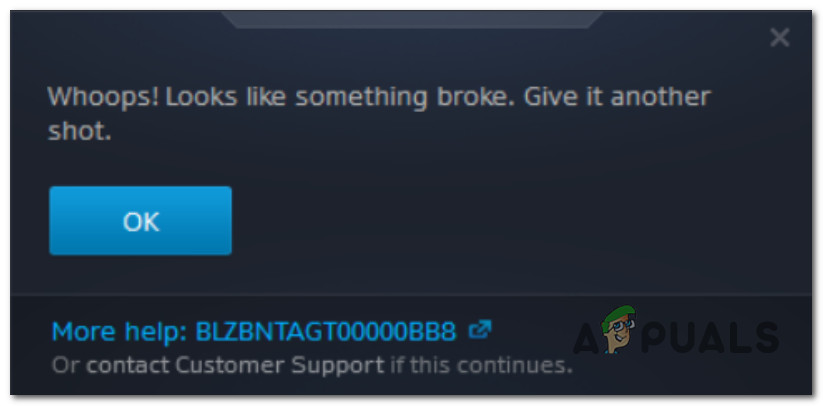
We’ve investigated this issue extensively and we realized that there are actually multiple causes that might ultimately cause these lingering issues when using the VoIP functionality on Battle.Net. Here’s a list of culprits that you should be aware of:
- Ongoing server issue – If it’s the first time you’re getting this error, you should start this troubleshooting guide by assuming you’re dealing with a temporary server issue. To make sure the issue is not beyond your control, start by checking if the problem is not occurring due to a temporary server issue or scheduled maintenance.
- Corrupted Battle.net cache – One of the most common causes that will trigger this error code (if the problem is not server-based) is a temporary file issue. You can fix the majority of these problems by clicking on Reload when the error occurs or by restarting the Battle.net client.
- Unreliable / Insufficient Connection – If you are forced to use a wireless connection from a limited ISP plan, chances are the available bandwidth is not enough to sustain the VoIP data transfer while you’re actively playing a game via Battle.net. In this case, you should be able to alleviate the problem by switching over to a wired connection.
- Background application hogging the bandwidth – If you’re working with a limited bandwidth supplied by your IPS, there’s also a chance that you see this error whenever Battle.net is unable to facilitate the packet data transfer because other applications are hogging up all the available bandwidth. In this case, you should close out any unnecessary application that is running in the background and is actively using the Internet.
- 3rd party security program interference – According to some affected users, you can also expect to deal with this issue in instances where the active antivirus or firewall that you’re using is blocking the connection with the Battle.net server due to a false positive. In this case, you can either disable or uninstall the overprotective security suite.
- Outdated GPU drivers – If you get this error immediately after you try to open up a game installed through Battle.net, chances are you’re using outdated GPU drivers that Battle.net no longer accepts. If this scenario is applicable, you can fix the issue by installing the latest GPU drivers & physics drivers for your graphics cards.
- Outdated Network drivers – If you only see this error occurring while attempting to use the VoIP functionality, you should also turn your attention towards your network drivers. If you haven’t done so already, make sure to update your Network drivers to the latest iterations available.
- Corrupted DNS Cache – Another reason why you might be encountering this error is a scenario in which the DNS cache has become corrupted. To fix it, you’ll need to flush your current DNS cache from an elevated Command Prompt window.
- The router is flooded with data – If you’re using a low-end router and you have a lot of different devices connected to it, chances are you’re experiencing this issue because it’s being overworked and it’s having trouble splitting the bandwidth to all available network participants. In this case, a network reboot or reset should fix the issue in most cases.
- The network is being funneled through a Proxy or VPN server – It’s common knowledge that Battle.net doesn’t play well with anonymity apps. If you’re using proxy or VPNs, you should temporarily disable them while you’re using Battle.net to avoid this error entirely.
Now that we went over every potential cause of the BLZBNTBNA00001388 error, let’s go over every potential fix that other affected users have successfully used to troubleshoot and fix this Battle.net issue.
1. Check for a server issue
Before you start troubleshooting the issue using the available methods below, our advice is to take some time and investigate whether the issue is beyond your control or not.
If the problem is indeed being caused by a server problem or Battle.net is in the middle of scheduled maintenance, none of the methods below will make a difference.
Start by checking the DownDetector page of Battle.net and check if other users in your area are having the same problem (take the time to read the latest comments on the bottom of the page).
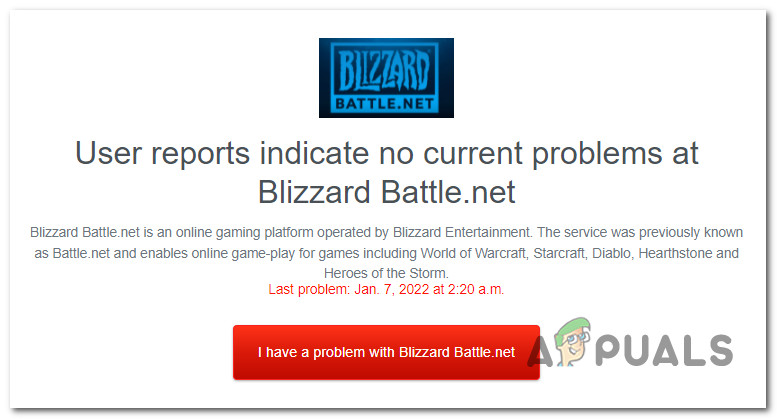
If you found evidence of an ongoing server problem, check the official Twitter account of Blizzard for an official announcement of the problem.
In case the investigation has not revealed an ongoing server issue, move down to the first potential fix below.
2. Clear up Temporary files
As it turns out, this problem can also be related to some type of inconsistency rooted in the cache file of the main Battle.net application.
When you get the BLZBNTBNA00001388 error, hit the Refresh button and see if the VoIP connection is established.
If that doesn’t work, go ahead and click on your account icon inside Battle.net, then click on Log Out from the context menu that just appeared.

Once you are logged out, insert your Battle.net credentials once again and see if the problem is now resolved.
If the problem is still not resolved after you hit Refresh and relaunched the main Battle.net app, move down to the next potential fix below.
3. Switch to a wired connection (if applicable)
If you’re using a wireless connection and you’re working with limited bandwidth or a low-end router, chances are that’s the main reason why you are frequently dealing with the BLZBNTBNA00001388 error.
VoIP is quite resource-consuming (especially if you’re on a limited ISP plan). Plus, this issue is likely amplified even more if there are several other devices connected to the same network.
If this scenario is applicable in your case, our advice would be to make the switch to an ethernet connection (instead of Wi-Fi) and connect to your home network via cable.

After you made the switch to an ethernet connection, see if the Battle.net problem is fixed.
If the problem is still not resolved, move down to the next potential fix below.
4. Close any unnecessary background applications
Another scenario that is likely applicable if you’re working with a limited Internet connection is a case where you have a lot of background programs that are eating away at the available bandwidth.
Note: P2P clients like uTorrent or BitTorrent will hog a lot of the available bandwidth even when you’re not downloading anything as items are being seeded across the P2P network.
If you’re experiencing this issue with Battle.net, make sure no applications are eating away at the bandwidth that the game launcher needs to use to facilitate VoIP and Online matchmaking.
To do this, open Task Manager (Ctrl + Shift + Esc), access the Processes tab, then go ahead and close every unnecessary program by right-clicking it and clicking on End Task from the context menu.

Note: If the simple interface of Task Manager is opened by default, click on More details to expand the Expert interface.
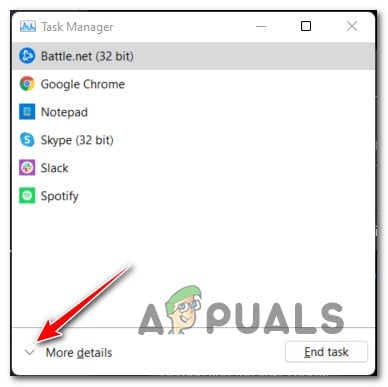
Once you’ve made sure that every potential program that might unnecessarily take up your Internet bandwidth is closed, return to Battle.net and see if the BLZBNTBNA00001388 error is fixed.
If the problem is still not resolved, move down to the next potential fix below.
5. Disable or Uninstall 3rd party security programs (if applicable)
Another fairly common issue that can ultimately cause the BLZBNTBNA00001388 error when using Battle.net is an overprotective antivirus that ends up blocking the data transfer between the game you are attempting to play and the Battle.net server.
Other users that have dealt with the same issue have confirmed that the problem was finally resolved after they either disabled or uninstalled the interfering 3rd party suite.
Note: Keep in mind that this method is only meant for those of you that use a 3rd party security suite (not Windows Security)
In case you are using an external antivirus that doesn’t include a firewall component, you should be able to resolve the problem just by disabling the real-time protection. In most cases, you can do this by accessing the tray bar icon of your antivirus.

On the other hand, if you’re using a 3rd party antivirus that includes a firewall component, the only available scenario to you is to uninstall the suite temporarily (at least until you conform to the issue) – this is necessary because the same security suite will remain in place even after you disable the real-time protection.
Note: If you conclude that your AV is to blame for the BLZBNTBNA00001388 error, you can replace it with a different 3rd party equivalent (or stick to using Windows Defender).
If you are forced to uninstall your currently active 3rd party antivirus, here’s what you need to do:
- Start by pressing Windows key + R to open up a Run dialog box. Next, type ‘appwiz.cpl’ and press Enter to open up the Programs and Features menu.
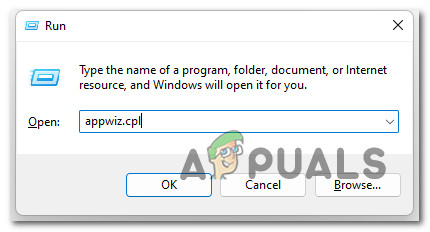
Open up the Programs and Features menu - Once you’re finally inside the Programs and Features menu, scroll down through the list of installed programs and locate the security suite that you wish to get rid of.
- Next, right-click on the 3rd party antivirus suite and choose Uninstall from the context menu to initiate the uninstallation process.

Uninstalling the problematic antivirus - Follow the remaining prompts to complete the uninstallation, then reboot your PC and see if the issue inside Battle.net is finally resolved.
If the problem is still not fixed, move down to the next potential fix below.
6. Update GPU Drivers
According to other affected users, this problem can also be caused by outdated GPU drivers, regardless of you’re using Nvidia or AMD. We now have confirmation from EA that the initial build of FIFA 22 had some rendering issues that have since been rectified via graphics drivers released by Nvidia and MD.
If the methods above didn’t fix the issue in your case and you’re still experiencing the BLZBNTBNA00001388 error, the next step should be to update your GPU drivers.
Here’s a quick guide on how to do this:
- Start by pressing Windows key + R to open up a Run dialog box. Next, type ‘devmgmt.msc’ inside the text box and press Enter to open up Device Manager.

Open up Device Manager - Inside Device Manager, scroll down through the list of installed devices and expand the drop-down menu associated with Display Adapters.
- Next, right-click on the dedicated GPU that you’re using when launching the game and choose Update driver from the newly appeared context menu.

Updating the GPU driver - Once you get to the next window, click on Search Automatically for updated driver software.
- Wait for the initial scan to complete before following the instructions to install the latest software available.
- Reboot your computer and see if the issue is resolved at the next system startup.
If Device Manager was unable to find a new GPU driver version, you should also try to use the proprietary driver updating software released by your GPU:
GeForce Experience - Nvidia
Adrenalin - AMD
Note: THese tools will automatically detect your GPU model and install the appropriate driver.
If you already had the latest GPU driver or updating to the latest version didn’t fix the issue for you, follow the next method below.
7. Update Network card drivers
As it’s been confirmed by several Battle.net users, this problem can also appear due to an outdated network adapter driver.
If this scenario is applicable, you can expect to see the BLZBNTBNA00001388 error as the connection with Blizzard servers is interrupted.
To make sure your network driver is not to blame for the issue, follow the instructions below to update it via Device Manager:
- Start by pressing Windows key + R to open up a Run dialog box.
- Next, type “devmgmt.msc” and press Enter to open up Device Manager. If prompted by the UAC (User Account Control), click Yes to grant admin access.
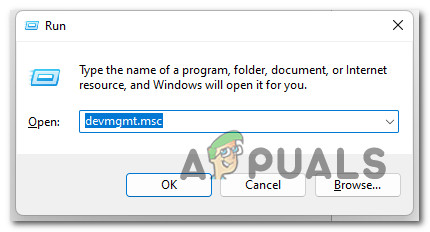
Open Device Manager - From the Device Manager window, expand the drop-down menu associated with Network Adapters and right-click on your network adapter.
- From the context menu that just appeared, and click on Properties.
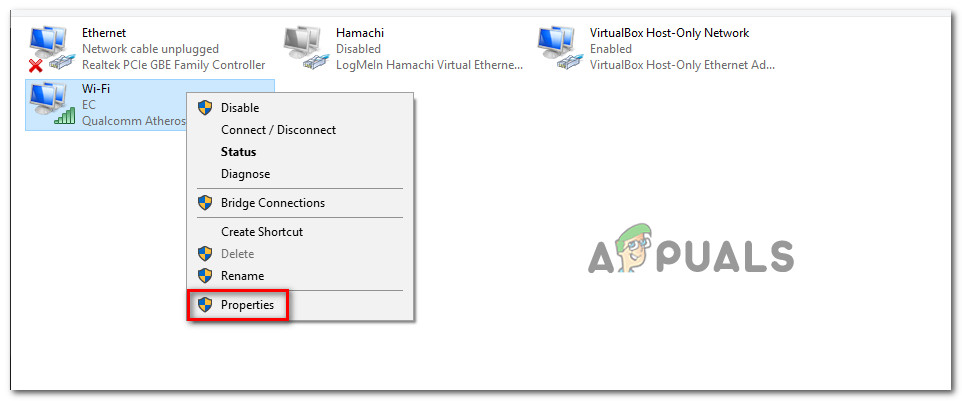
Accessing the Properties screen - Inside the Properties menu, select the Driver tab, then click on Update driver.

Update the Network driver - From the next screen, click on Search Automatically for updated driver software.
- Wait patiently until the scan is complete, then follow the on-screen instructions to install the latest version available.
- When the new driver version is installed, reboot your PC and see if the problem is now fixed.
If this method didn’t work in your case, move down to the next potential fix below.
8. Flush your DNS cache
In case you’re experiencing this issue in and off, chances are the problem is related to some kind of network inconsistency that’s facilitated by a bad DNS (Domain Name System) cache. In this case, you can expect this type of issue to occur when the connection with Battle.Net servers is terminated prematurely.
If this scenario is applicable, you should be able to fix the problem (on any Windows version) by doing a DNS flush – this operation will clear the DNS cache allowing your router to restart the connection with no temporary files.
Follow the instructions below for specific steps on doing a DNS cache:
- Start by opening a dialog box by pressing Windows key + R.
- Type ‘cmd’ inside the text box, then press Ctrl + Shift + Enter to open up an elevated Command Prompt.
- When you see the User Account Control (UAC) prompt, click Yes to grant admin access.

Open up a CMD prompt - Inside the elevated CMD Prompt, type the following command and press Enter to effectively flush the DNS cache on your PC:
ipconfig/flushdns
Note: This operation will remove any information that is currently stored in the DNS cache – this will force the router to assign a brand new DNS range.
- Once the command is successfully processed, close the elevated CMD prompt, reboot your PC and see if the Battle.net issue is resolved once the next startup is complete.
If the BLZBNTBNA00001388 error is still occurring, move down to the next method below.
9. Restart or Reset your Router
If you’re using a wireless connection when playing a game that’s launched via Battle.net, it’s possible that you’re seeing this error due to the fact that it has become flooded with data.
This is quite common with certain router models with limited bandwidth – especially if multiple connected devices are actively drawing from the bandwidth.
In this case, there are a few troubleshooting methods that you should consider.
Router Reboot
This fix was confirmed to be effective by a lot of users that we’re experiencing the BLZBNTBNA00001388 error with Battle.net.
To enforce this fix, press the Off button on the rear of your network device and wait for a full minute before starting your router once again.
IMPORTANT: While your router is turned off, take the time to remove the power cable from the power outlet in order to ensure that the power capacitors are completely drained.
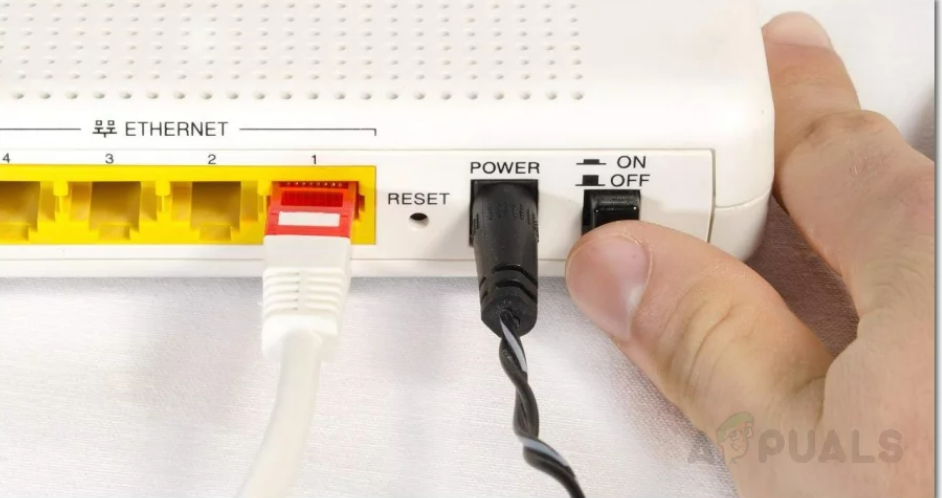
Note: As opposed to a router reset, this procedure will not reset any custom settings or credentials.
Rebooting Router
If the method above didn’t work in your case, you should also go for a router reset. This will work in scenarios where a custom network setting is interfering with Battle.net.
Note: A router reset operation will end up clearing any personalized settings that you previously established – This includes any forwarded ports, custom credentials, whitelists, and blocked items.
To do this, look for the reset button on the back of your router. In most cases, you will need a toothpick or something similar to reach it.
IMPORTANT: Some routers are configured to ‘forget’ the PPPoE credentials when a reset is performed. If your ISP is using this login method, ensure that you have the credentials at the ready so you can re-establish the Internet connection once the operation is complete.
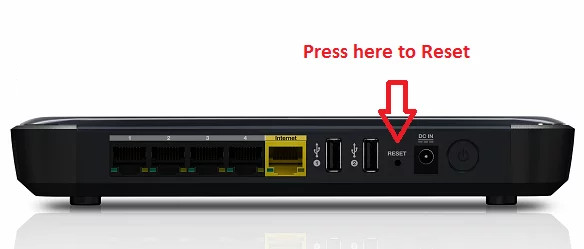
You might need to use a sharp object to press and hold the Reset button until you see all the front LEDs flash at once, then release the button. After you see this behavior, re-insert the ISP connections to establish the Internet connection if necessary, then restart your PC and see if the problem is fixed.
If you’re still experiencing the same BLZBNTBNA00001388 error, move down to the next method below.
10. Disable Proxy and VPN Connections (if applicable)
If none of the methods above have been effective for you, you should also consider terminating any proxy or VPN connections that you might be currently using on your PC.
It’s a well know fact that Battle.net doesn’t play well with Proxy servers or VPN clients. And as it turns out, a lot of anonymity services are outright being blocked from engaging in data exchanges.
Several affected users have reported that they’ve only been able to resolve the issue by disabling their proxy server or VPN client that they were using.
We created two separate guides that will help you disable your VPN or proxy server in case this method is applicable.
Disable Proxy server
If you’re using a proxy server, you’ll need to access the Proxy menu inside the Window Setting menu and terminate the connection manually.
Here’s how:
- Start by opening up a Run dialog box by pressing Windows key + R. Next, type ”ms-settings:network-proxy’ and press Enter to open up the Proxy tab of the Settings app.

Accessing the proxy server - Inside the Proxy tab of the Settings menu, move down to the Manual Proxy Setup section.
- Next, go to the right-hand section of the screen and uncheck the box associated with Use a proxy server.
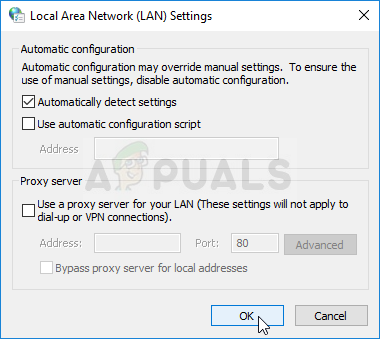
Disable the Proxy server - After you manage to disable the Proxy server, restart your computer and see if the problem is resolved at the next computer startup by opening Battle.net again.
Disable VPN server
Disabling the VPN client is dependent on the type of implementation that you’re using. If you installed a desktop VPN client, you will need to access the specific settings menu and disable the VPN connection from there.
On the other hand, if you have set up a VPN connection through the Windows 10 built-in feature, here’s a quick guide on disabling it:
- Start by pressing Windows key + R to open up a Run dialog box.
- Next, type ‘ms-settings:network-vpn’ and press Enter to open up the VPN tab of the Settings app on your Windows computer.

Access the VPN client - Inside the VPN connection tab, move over to the right-hand side section and click on your VPN, then click Remove from the context menu to prevent it from interfering with the Battle.net application.
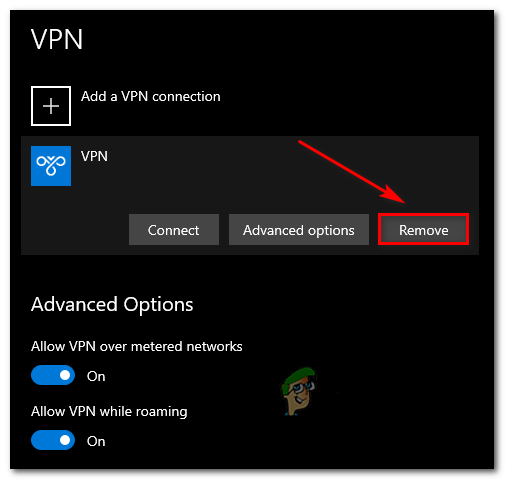
Remove the VPN connection
If the problem is still not fixed, move down to the next potential fix below.
11. Contact Blizzards Support Team
If none of the methods above have proven to be effective in your case, the last resort method is to open a ticket at Blizzard and get support from an agent that will help you troubleshoot the issue further.
To do this, access the official support page, sign in with the same account that you use on Battle.net, then go through the process of opening a ticket.

Note: You can expect to get an official replay in under 24 hours.





